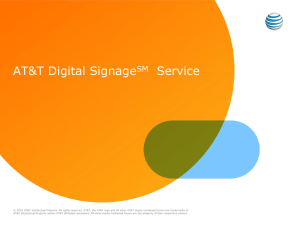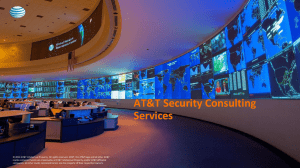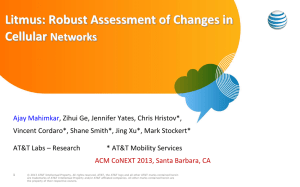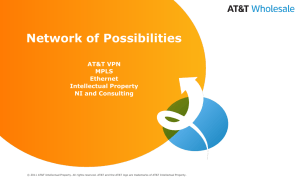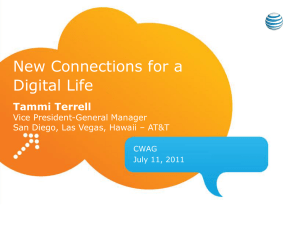D1 6 Martin-Stroman Power
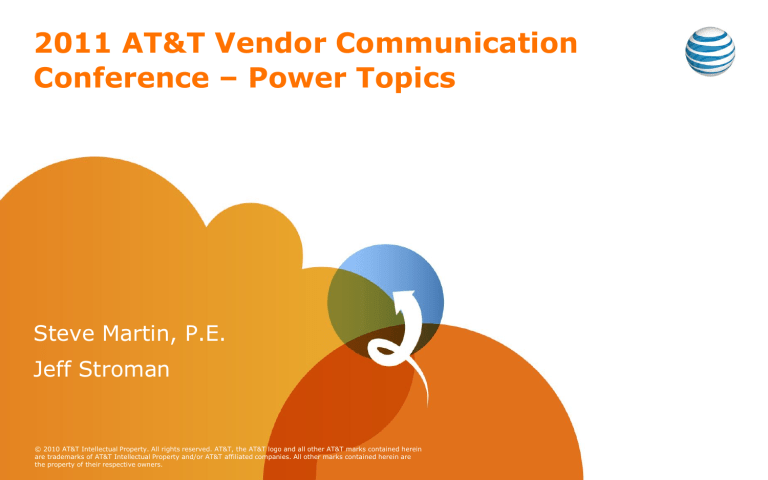
2011 AT&T Vendor Communication
Conference – Power Topics
Steve Martin, P.E.
Jeff Stroman
© 2010 AT&T Intellectual Property. All rights reserved. AT&T, the AT&T logo and all other AT&T marks contained herein are trademarks of AT&T Intellectual Property and/or AT&T affiliated companies. All other marks contained herein are the property of their respective owners.
Waivers, ERCNs, and IRCNs
Steve Martin, P.E.
2 © 2010 AT&T Intellectual Property. All rights reserved. AT&T, the AT&T logo and all other AT&T marks contained herein are trademarks of AT&T Intellectual Property and/or AT&T affiliated companies. All other marks contained herein are the property of their respective owners.
3
Power Waivers – Exponential Growth
256
389
663
Reduction Strategies
• 20% are dismissed
• If the TP lists an exception, and your situation meets that exception, no waiver is required.
• Description is inadequate.
• 10% for issues that will always be denied
• < 3” bus bar clearance, < 30” battery aisle space, mixing fused and unfused cable, etc.
• Target top 25% for IRCN / ERCN
• 7% for AC outlets; 1 since IRCNs / ERCNs were published.
• Primary and secondary shared cable rack (9%) and cable passing thru the rungs (5%) are in process of being updated.
2008 2009 2010
© 2010 AT&T Intellectual Property. All rights reserved. AT&T, the AT&T logo and all other AT&T marks contained herein are trademarks of AT&T Intellectual Property and/or AT&T affiliated companies. All other marks contained herein are the property of their respective owners.
Recent Power ERCNs and IRCNs
AC Test Receptacles – 12’ Rule
• “Every 3rd bay” rule has lost meaning with the implementation of large spacers and skipped bay spaces.
• Mobility had no specific requirement for test outlets.
• Some alternate methods of providing AC outlets (under raised floor, mounted on aux framing overhead) were causing safety concerns.
• Smaller sites with alternate outlets in walls or sites where
AT&T is a tenant / guest and has no control over the location of AC outlets were not addressed with the existing language.
4 © 2010 AT&T Intellectual Property. All rights reserved. AT&T, the AT&T logo and all other AT&T marks contained herein are trademarks of AT&T Intellectual Property and/or AT&T affiliated companies. All other marks contained herein are the property of their respective owners.
Recent Power ERCNs and IRCNs
SPDU Modification Matrix
Type of Modification
Plug-in Circuit Breaker
Tier 1 Supplier Authorized to Perform
Work
Transport or Power
Plug-in Fuse Block Transport or Power
Plug-in (Bullet) Disconnect Switch
Bolted Fused Disconnect Switch
(e.g. replace two single space TPS with one dual space TPL)
Panel, Bus Bar, Shunt
Adding / Splitting Primary Loads
Transition secondary loads to a different
SPDU
Transport or Power
Power
Power
Power
Power
5 © 2010 AT&T Intellectual Property. All rights reserved. AT&T, the AT&T logo and all other AT&T marks contained herein are trademarks of AT&T Intellectual Property and/or AT&T affiliated companies. All other marks contained herein are the property of their respective owners.
Recent Power ERCNs and IRCNs
Power Cable Color
BDFB
Designation
Gray
Red
Blue
PBD to
BDFB
BAT & RTN
Gray
Red
Blue
BDFB to
FAP
BAT & RTN
Gray
Red
Blue
PBD or BDFB to
Equipment (Direct)
BAT & RTN
Gray
Red
Blue
FAP to Equipment
BAT
Red
Red
Red
RTN
Black
Black
Black
6 © 2010 AT&T Intellectual Property. All rights reserved. AT&T, the AT&T logo and all other AT&T marks contained herein are trademarks of AT&T Intellectual Property and/or AT&T affiliated companies. All other marks contained herein are the property of their respective owners.
Recent Power ERCNs and IRCNs
Why stagger transition devices?
Too
Much
Heat!
Section K ¶ 4.4.8 was a duplicate of section J ¶ 2.1.14.
2 nd IRCN was simply eliminating the redundancy.
7 © 2010 AT&T Intellectual Property. All rights reserved. AT&T, the AT&T logo and all other AT&T marks contained herein are trademarks of AT&T Intellectual Property and/or AT&T affiliated companies. All other marks contained herein are the property of their respective owners.
Too
Little
Heat!
Standard Build Program
Jeff Stroman
8 © 2010 AT&T Intellectual Property. All rights reserved. AT&T, the AT&T logo and all other AT&T marks contained herein are trademarks of AT&T Intellectual Property and/or AT&T affiliated companies. All other marks contained herein are the property of their respective owners.
Test & Acceptance
• AT&T Power Engineers have been receiving requests to add
FPQ for “test and acceptance”.
• Power Building Blocks that install equipment requiring test and acceptance contain an included work note:
– “Testing, validation, verification, and acceptance activities in support of ATS pre-acceptance or acceptance of the work.”
• Power OTVs should not add FPQ for “test and acceptance” or any other synonymous activity. The compensation for these activities is already included in the Building Block Price Caps where appropriate.
9 © 2010 AT&T Intellectual Property. All rights reserved. AT&T, the AT&T logo and all other AT&T marks contained herein are trademarks of AT&T Intellectual Property and/or AT&T affiliated companies. All other marks contained herein are the property of their respective owners.
Minor Material Pricing Discrepancies
• AT&T Power Engineers have been receiving requests to add
FPQ for “minor material pricing discrepancies”.
• Standard procedure when a Power OTV notices a discrepancy in pricing of minor material or any component of a Building
Block Price Cap is to complete a Building Block Price Cap
Dispute Form and submit it to AT&T GBOS (Procurement,
Supply Chain, etc.) for review.
• Power OTVs should not attempt to add FPQ to quotes for perceived discrepancies on pricing of minor material.
10 © 2010 AT&T Intellectual Property. All rights reserved. AT&T, the AT&T logo and all other AT&T marks contained herein are trademarks of AT&T Intellectual Property and/or AT&T affiliated companies. All other marks contained herein are the property of their respective owners.
Minor Material Pricing Examples
• On a recent vendor quote review the following text was included as justification for adding Driver DC-FPQ003 in the amount of $53,326:
– “Material not covered by Building Blocks. Additional cost associated with cable , lugs , and in-line reducers ”
• Building Blocks for DC power cabling such as BC-CAP0xx and their associated DC-CAP0xx and DC-CAP0xxX Drivers contain the following included work note:
– Cabling of one DC power circuit or paired run, both discharge & return, up to 10 ft. each, including terminations (i.e. flexible wire drops, lugs , inline splices , fuses, etc.).
• The requested FPQ was rejected. Do not add FPQ.
11 © 2010 AT&T Intellectual Property. All rights reserved. AT&T, the AT&T logo and all other AT&T marks contained herein are trademarks of AT&T Intellectual Property and/or AT&T affiliated companies. All other marks contained herein are the property of their respective owners.
Labor Effort Pricing Discrepancies
• AT&T Power Engineers have been receiving requests to add
FPQ for “extra labor or effort due to difficult cable runs”.
• Standard procedure when a Power OTV notices a discrepancy in pricing of installation labor or any component of a Building
Block Price Cap is to complete a Building Block Price Cap
Dispute Form and submit it to AT&T GBOS (Procurement,
Supply Chain, etc.) for review.
• Power OTVs should not attempt to add FPQ to quotes for perceived discrepancies on pricing of labor or perceived differences in labor effort.
12 © 2010 AT&T Intellectual Property. All rights reserved. AT&T, the AT&T logo and all other AT&T marks contained herein are trademarks of AT&T Intellectual Property and/or AT&T affiliated companies. All other marks contained herein are the property of their respective owners.
Labor Effort Pricing Examples
• On a recent vendor quote review the following text was included as justification for adding Driver DC-FPQ002 in the amount of $20,696:
– “ Additional labor not covered by Building Blocks due to difficulty of cable route”
• The Standard Build Program Guidelines contain the following admonition under the section detailing use of FPQ Drivers:
– There should never be any inappropriate use of a FPQ BB/DR to pay for anything that is already included in other BBs/DRs. That includes the use of FPQ Drivers for what the OTV might generally describe as “ extra effort ”.
• The requested FPQ was rejected. Do not add FPQ.
13 © 2010 AT&T Intellectual Property. All rights reserved. AT&T, the AT&T logo and all other AT&T marks contained herein are trademarks of AT&T Intellectual Property and/or AT&T affiliated companies. All other marks contained herein are the property of their respective owners.
Timing of Building Block Releases
• The fluctuating cost of some commodities, especially copper, causes pricing discrepancies in the Standard Build Program’s
Building Block and Driver Price Caps from time to time.
• In order to address this AT&T has worked with several suppliers of AIW Southwire to ensure that pricing information is provided about the first week of odd numbered months to coincide with pricing adjustments effective from AIW
Southwire on the 15 th of odd numbered months.
• AT&T is timing Building Block releases as soon as possible after these adjustments. Are Power OTV contract managers interested in reducing the contractual 30 day announcement cycle to better accommodate these adjustments?
14 © 2010 AT&T Intellectual Property. All rights reserved. AT&T, the AT&T logo and all other AT&T marks contained herein are trademarks of AT&T Intellectual Property and/or AT&T affiliated companies. All other marks contained herein are the property of their respective owners.

